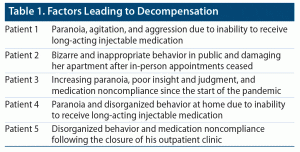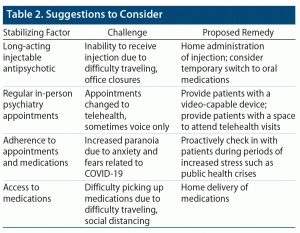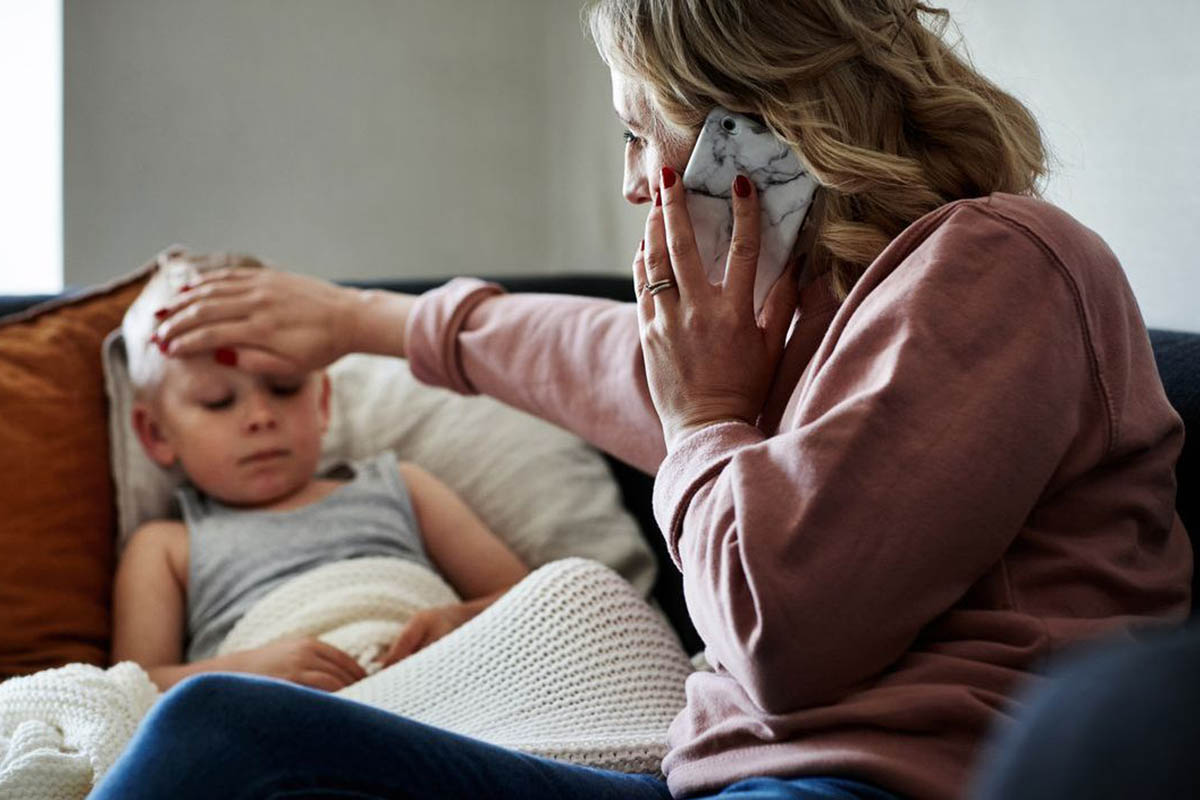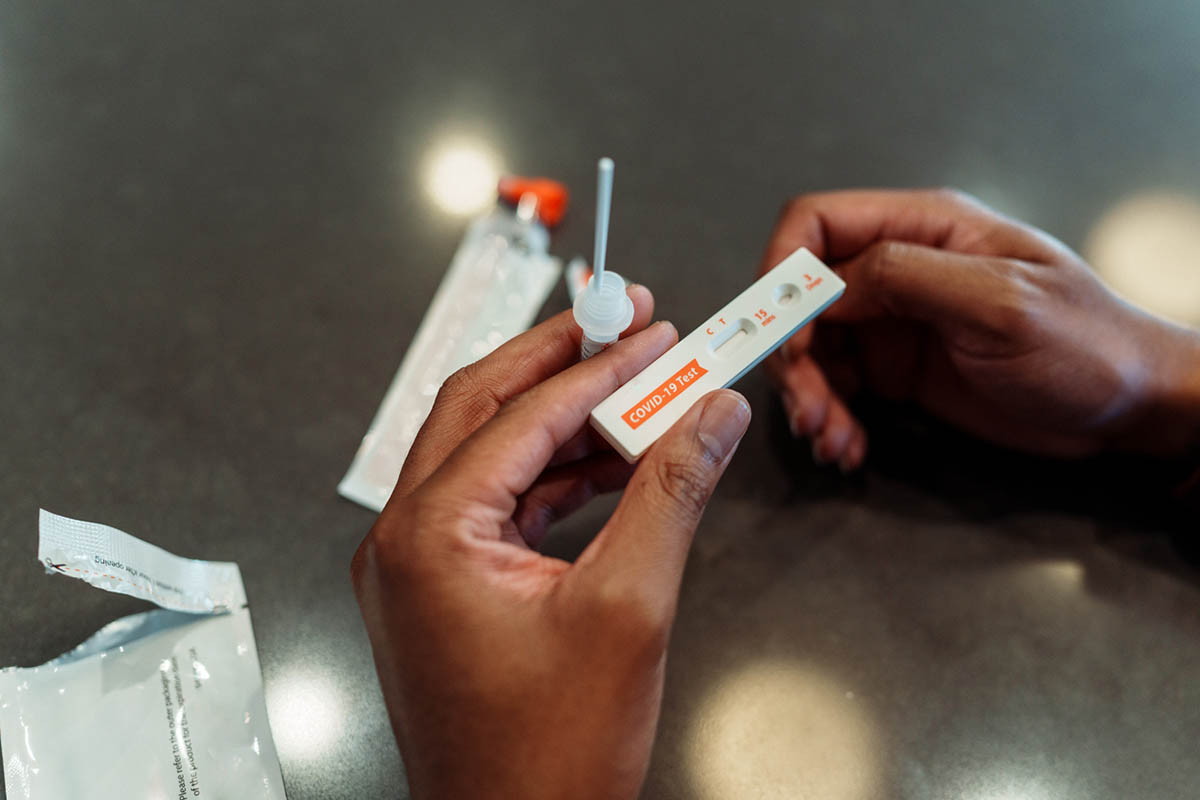
Prim Care Companion CNS Disord 2021;23(3):21cr02955
To cite: Jay JA, Garrels E, Korenis P. Psychiatric decompensation during the COVID-19 pandemic: a literature review and case series. Prim Care Companion CNS Disord. 2021;23(3):21cr02955.
To share: https://doi.org/10.4088/PCC.21cr02955
© Copyright 2021 Physicians Postgraduate Press, Inc.
aDepartment of Psychiatry, BronxCare Health System, Bronx, New York
*Corresponding author: Joshua A. Jay, MD, 1276 Fulton Ave, Bronx, NY 10456 ([email protected]).
The effects of the coronavirus disease 2019 (COVID-19) pandemic on mental health have been broad and well documented. Patients suffering from psychotic disorders appear to be particularly vulnerable to decompensation.1,2 In addition to being a source of heightened anxiety, the pandemic has disrupted patients’ access to care and protective elements offered by their usual routines.3,4 Previous research looking at the COVID-19 pandemic as well as previous epidemics and pandemics has demonstrated that the effects on mental health are not always uniform.1,5 A recent review1 found the incidence of psychosis in those infected by a virus during an epidemic or pandemic to range from 0.9% to 4%. The effect of public health crises such as the current pandemic on mental health and particularly on psychosis clearly deserves attention.
We report 5 cases of patients with preexisting psychotic disorders seen on the inpatient psychiatry unit of an inner-city community hospital who decompensated for various reasons relating to the pandemic. These patients were not followed after discharge, so we cannot comment on their progress in the community. The specifics of these cases can shed light on the different ways in which the pandemic can lead to poor mental health outcomes in those most vulnerable. It is our hope to use the lessons we are currently learning from our patients to mitigate the effects of the current pandemic, to be better prepared as mental health practitioners for future public health crises, and to determine what changes can be made to practice in general to benefit our patients even under normal circumstances.
Case Reports
Case 1. A 36-year-old man with a history of schizophrenia was brought to the medical emergency department (ED) by his family to receive his psychiatric medications. The patient had been receiving haloperidol decanoate injections for some time, but had been unable to receive them for the past 3 months because his regular clinic had closed due to the pandemic. His family brought him to the ED in an attempt to reestablish his monthly injections, as they did not know where else to turn. In the ED, the patient was extremely agitated and aggressive, and he was eventually admitted to the inpatient psychiatry unit. He was started on oral medication and gradually improved. He was eventually resumed on his long-acting injectable (LAI) medication and deemed stable for discharge.
Case 2. A 50-year-old woman with a history of schizophrenia was sent to the psychiatric ED by staff at her residence for bizarre, inappropriate, and destructive behavior. She had not been admitted to an inpatient psychiatry unit in over 5 years. The patient had previously attended in-person psychiatry appointments consistently, but these changed to voice-only telehealth appointments after the onset of the pandemic. Upon calling the patient’s pharmacy, it was discovered that she had not picked up her medications in over 2 years. On initial assessment, the patient was guarded, internally preoccupied, and paranoid. She was subsequently admitted to the inpatient psychiatry unit. She was resumed on her medications, which were then titrated to a higher dose. She improved and was deemed stable for discharge, though she exhibited some residual paranoia and refused LAI medication.
Case 3. A 55-year-old woman with a history of schizoaffective disorder presented to the medical ED with complaint of a headache. She appeared paranoid and disorganized and was admitted to the inpatient psychiatry unit. Per collateral information from the patient’s son and outpatient psychiatrist, she had previously been functional and able to work, but she started to become increasingly paranoid since March 2020, particularly about traveling to work on public transportation at the height of the pandemic. She eventually stopped working, became extremely paranoid, and stopped taking her medications due to paranoid beliefs. The patient was resumed on her medication, but remained extremely paranoid and was found to be “cheeking” her pills. After a family meeting with her son, the patient became adherent to her medication and began to improve. She also agreed to LAI medication. She returned to her baseline level and was discharged.
Case 4. A 59-year-old woman with a history of schizoaffective disorder was brought to the medical ED by emergency medical services due to agitation and aggressive behavior. She was admitted to the inpatient psychiatry unit. Per the patient’s family, she had been maintained on haloperidol decanoate as well as oral haloperidol and valproic acid previously but had been unable to receive her LAI medication due to restrictions related to the pandemic. During this time, the patient attempted to establish care at a different clinic but was unable to do so and did not receive haloperidol decanoate for 3 months prior to this admission. Upon admission, she was resumed on her oral medications. She improved very gradually, as the doses were titrated and she had to be encouraged to take her medications consistently due to paranoia. Eventually, she agreed to resume her LAI medication and was deemed stable for discharge.
Case 5. A 19-year-old man with a past psychiatric history of schizophrenia was brought to the medical ED by his father after the patient reported to his parents that he was hearing voices, seeing bright colors around the room, and stopped taking his antipsychotic medications weeks ago. He was admitted to the inpatient psychiatry unit. As per the patient’s father, he was attending groups and appointments with his psychiatrist regularly until COVID-19 began, which caused the closure of the clinic he was attending. Without consistent follow-up, he became noncompliant with his medication, leading to psychiatric decompensation in the form of auditory and visual hallucinations, paranoia, and ideas of reference. The patient improved on oral medications, agreed to LAI medication, and was discharged at his baseline level.
Discussion
In these cases, we identified various challenges that arose due to the COVID-19 pandemic. In each case, the challenge identified caused the patient to destabilize and decompensate. The specifics of each case can help to identify the factors that serve to keep our patients stable under normal circumstances as well as how those factors were disrupted by the pandemic. In our first case, a patient who had been maintained on an LAI antipsychotic (in this case haloperidol decanoate) found himself unable to access this treatment for several months. There are many ways in which the pandemic has made accessing these treatments difficult such as offices having limited hours or closing outright, providers moving to telehealth only, public transportation being scaled back, and people generally heeding the advice not to leave their homes or being frightened to do so.
In our second case, a patient who regularly attended her in-person psychiatry appointments suddenly only had telephone appointments available to her. During this patient’s hospital course, it was discovered that she had not been compliant with any of her medications and her regular appointments seemed to be the most significant factor keeping her stable. While in-person visits may have been all but impossible during certain stages of the current pandemic, telehealth visits using videoconferencing technology would almost certainly be a more efficacious substitute than a simple phone call. Unfortunately, many patients may not have video-capable devices, making telehealth appointments with video impossible. It is also possible that some providers do not offer this service.
In our third case, a patient decompensated due to paranoia resulting from the pandemic. Due to fears about traveling to work on public transportation during the pandemic, the patient became increasingly paranoid, causing her to stop working and become noncompliant with her treatment. The COVID-19 pandemic has been a significant stressor to many, causing increased fear and anxiety. Many of our patients are particularly susceptible to such stressors, as even a minor disruption in routine can cause a patient with a psychotic disorder to decompensate.
In our fourth case, a patient experienced difficulty receiving follow-up care and sought to establish care with a new provider but was unable to do so. During the pandemic, many patients have found it difficult to maintain follow-up care, even when they were motivated to do so, due to the various restrictions. This could mean losing access to LAI medications, to oral medications, or to appointments with one’s psychiatrist altogether.
In our fifth case, a patient required both medication and in-person appointments and groups to remain stable in the community before the closure of his clinic resulted in the loss of in-person meetings. This case demonstrates how some patients require a multifaceted approach to remain stable in the community and how interruption in one of the facets can be enough to cause destabilization. With COVID-19 impacting so many different aspects of the health care system, these patients are extremely vulnerable to decompensation (Table 1). The various measures taken to slow the spread of COVID-19, while necessary overall, have certainly come at a cost.
The challenges faced during this period have forced us to think creatively in proposing changes in the delivery of care, which may well be worthwhile even once the COVID-19 pandemic is fully behind us. We believe that the following suggestions are worth consideration both to mitigate the detrimental effects the pandemic is having on our patients and to improve the quality of the delivery of mental health care. For patients experiencing difficulty accessing oral medications, a home delivery service could be helpful. For patients having difficulty receiving an LAI medication, we could consider a model in which a provider visits a patient to administer the injection at home. We already have a model for this type of care for patients who have an assertive community treatment team. We should consider expanding the reach of such teams during situations such as a pandemic when patients have difficulty traveling to appointments. Alternatively, if this is not feasible, it could be worthwhile to consider switching a patient to oral medications temporarily. LAI medications are conventionally thought to increase compliance, as they are administered far less frequently than oral medications that typically need to be taken every day. However, it is possible that this assumption did not always hold during the pandemic due to the difficulty of traveling and keeping appointments due to office closures. In the era of telehealth visits, patients should be given the opportunity to both see and hear their doctor to have as close a replication of an in-person visit as possible. Many patients with psychotic disorders may not have access to devices that would allow for this due to a variety of factors. One solution would be to provide patients with a device that would allow for such visits. Another would be to provide a space wherein the patient can go to participate in a video conference appointment. As we saw in our case, this can be an essential component of maintaining a patient’s mental health, and it is incumbent on the medical community to consider the necessity of providing these therapeutic measures. It is also important for any physician considering moving to a telehealth model to carefully consider the risks and benefits of doing so and to determine whether this would ultimately be in the public’s as well as their patients’ best interests. Regardless, it must be kept in mind that even the most ideal telehealth appointment may not always be a perfect replacement for an in-person visit. Our final recommendation is for more proactive and frequent check-ins with patients at high risk for decompensation during challenging periods such as the onset of a pandemic. Psychiatrists or other office or hospital staff can proactively call established patients to check on how they are managing the situation and whether they are experiencing any barriers to treatment compliance. A more proactive approach could prevent patients from becoming paranoid and decompensating due to the stresses of a public health crisis or similar situation. Table 2 provides suggestions to consider.
Conclusion
The COVID-19 pandemic presents us with an opportunity to identify ways in which our patients are at risk and how we can attempt to better serve them going forward. Many patients with psychotic disorders are at risk for disruptions in their access to regular care even outside the context of a pandemic. By appreciating the multifaceted ways in which the current situation has affected our patient population, we can extrapolate lessons that will allow us to better serve our patients even when this pandemic passes.
Received: February 16, 2020.
Published online: June 3, 2021.
Potential conflicts of interest: None.
Funding/support: None.
Patient consent: Verbal consent was obtained from the patients to publish these case reports, and all patient information has been deidentified to protect anonymity.
References (5)

- Brown E, Gray R, Lo Monaco S, et al. The potential impact of COVID-19 on psychosis: a rapid review of contemporary epidemic and pandemic research. Schizophr Res. 2020;222:79–87. PubMed CrossRef
- Vieta E, Pérez V, Arango C. Psychiatry in the aftermath of COVID-19. Rev Psiquiatr Salud Ment. 2020;13(2):105–110. PubMed CrossRef
- Dubey S, Biswas P, Ghosh R, et al. Psychosocial impact of COVID-19. Diabetes Metab Syndr. 2020;14(5):779–788. PubMed CrossRef
- Lazzari C, Shoka A, Nusair A, et al. Psychiatry in time of COVID-19 pandemic. Psychiatr Danub. 2020;32(2):229–235. PubMed CrossRef
- Torales J, O’Higgins M, Castaldelli-Maia JM, et al. The outbreak of COVID-19 coronavirus and its impact on global mental health. Int J Soc Psychiatry. 2020;66(4):317–320. PubMed
Please sign in or purchase this PDF for $40.







